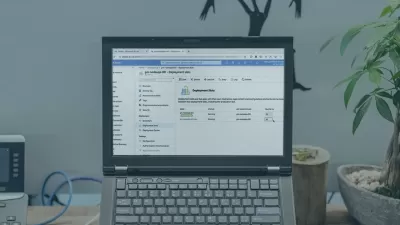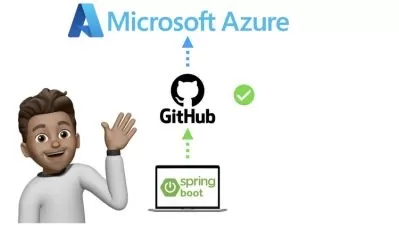Azure IT Administration Microsoft Course with SIMULATIONS
John Christopher
15:24:56
Description
Learn how to expertly administer Microsoft Azure IT Administration with lecture and hands on simulations available 24/7
What You'll Learn?
- Learn the concepts and perform hands on activities needed to master Microsoft Azure IT Administration
- Gain a tremendous amount of knowledge involving Microsoft Azure IT Administration
- Learn using hands on simulations on how Microsoft Azure IT Administration
- Learn how to set up your own test lab for practicing the concepts!
Who is this for?
More details
DescriptionWe really hope you'll agree, this training is way more than the average course on Udemy!
Have access to the following:
Training from an instructor of over 20 years who has trained thousands of people and also a Microsoft Certified Trainer
Lecture that explains the concepts in an easy to learn method for someone that is just starting out with this material
Instructor led hands on and simulations to practice that can be followed even if you have little to no experience
TOPICS COVEREDÂ INCLUDINGÂ HANDSÂ ONÂ LECTUREÂ ANDÂ PRACTICEÂ TUTORIALS:
Introduction
Welcome to the course
Understanding the Microsoft Environment
Having a Solid Foundation of Active Directory Domains
Having a Solid Foundation of RAS, DMZ, and Virtualization
Having a Solid Foundation of the Microsoft Cloud Services
Questions for John Christopher
Setting up for hands on
IMPORTANT Using Assignments in the course
Creating a free Azure Account
Activating Azure AD P2 license
Understanding Azure Subscriptions, Costs and Resources
The Azure Shared responsibility model
Subscriptions in Azure
Using management groups in Azure
Learning to manage costs with alerts and budgets in Azure
Use cases for IaaS, PaaS, and SAAS
Using resource groups in Azure
Tagging resources in Azure
Adding locks to resources in Azure
Using Azure Policies to control Azure Resources
Understanding Azure Active Directory (Azure AD) management and access control
User identity creation in Azure Active Directory (Azure AD)
Group creation and management in Azure AD
Properties involved in Users and Groups
Device settings in Azure AD
Using administrative units in Azure AD
License management in Azure AD
Implementing self-service password reset (SSPR) in Azure AD
Assigning Roles in Azure AD
Using role-based access control (RBAC) to create custom roles
Assigning roles at different scopes
Understanding access assignments
Understanding Azure PowerShell and Cloudshell
Foundational concepts of PowerShell
Connecting PowerShell to Azure
Using PowerShell with Azure AD
Azure Cloudshell
Azure CLI / Bash
Azure CLI installed locally
Understanding Virtual Networks (vNets) and Virtual Subnets in Azure
Concepts of using virtual networks and subnets in Azure
Azure virtual network and subnet creation
Using PowerShell to create vNets
Peering virtual networks in Azure
Private and public IP addresses in Azure
Azure DNS management
Using network security groups (NSGs) and ASGs in Azure
Using User Defined Routes (UDRs) in Azure
Understanding the concepts of service endpoints and private endpoints
Using service endpoints in Azure
Effective rules in an NSG
Azure Bastion creation in Azure
Understanding Azure Load Balancers
Azure load balancing concepts
Internal vs public load balancing
Azure Application Gateway load balancing
Understanding the Azure Firewall
Using a router table to direct traffice to the Azure Firewall
Setting up an Azure Firewall
Azure Firewall Manager
Understanding virtual networking monitoring and troubleshooting
Using Azure Monitor for monitoring networks
Azure Network Watcher
Virtual network connectivity troubleshooting
External network troubleshooting
Azure DDoS Protection
Understanding storage in Azure
Concepts of working with storage accounts
Storage account creation in Azure
Implementing network access to storage accounts
Configuring a storage account to use Azure AD authentication
Storage account access keys in Azure
Creating shared access signature (SAS) tokens
Using stored access policies
Import and export jobs
Concepts of using storage redundancy in Azure
Using storage redundancy in Azure
Object replication
Azure file share and Configuring storage tiers configuration
Azure Blob storage management
Working with blob lifecycle management
Understanding Virtual Machines (VMs) creation and Azure Resource Manager (ARM) templates
Creating a Virtual Machine (VM) in Azure
Using PowerShell to create a virtual machine in Azure
Managing disk encryption
Moving virtual machines between resource groups
Resizing virtual machines in Azure
Adding data disks
Implementing network settings with virtual machines
Options for virtual machine availability
Using virtual machine scale sets in Azure
Managing Azure Resource Manager (ARM) templates
Azure Resource Manager (ARM) template deployment
How to save an existing deployment as an ARM template
Virtual machine (VM) extensions
Understanding Azure App Services
Concepts of using App Service Plans
App Service plan deployment
App Service plan scaling configuration
App Service creation
Networking settings in App Services
Deployment settings with App Services
Custom domain names
Backups for App Services
App Service Security
Understanding Container and Kubernetes Services
Concepts of working with Azure Containers
Azure Container Instance sizing and scaling
Concepts of container groups
AKS Scaling
Azure Kubernetes Service (AKS) storage
Upgrading an AKS cluster
AKS network connectivity
Understanding basic database management in Azure
Setting up SQL Database/Server and using SSMS to connect
SQL firewall settings for client connections
Using database authentication with Azure AD
SQL database auditing
Understanding backup and recovery in Azure
Azure Recovery Services vault deployment
Backup policies
Azure backup and restoration
Using backup reports
Azure Site Recovery
Understanding Azure Monitor
Using metrics in Azure Monitor
Azure Monitor logs
Azure Monitor alerts and actions
VM, storage accounts, and network monitoring
Using the Azure Advisor
Finishing Up
Where do I go from here?
Who this course is for:
- IT people interested in learning a tremendous amount about Microsoft Azure administration
We really hope you'll agree, this training is way more than the average course on Udemy!
Have access to the following:
Training from an instructor of over 20 years who has trained thousands of people and also a Microsoft Certified Trainer
Lecture that explains the concepts in an easy to learn method for someone that is just starting out with this material
Instructor led hands on and simulations to practice that can be followed even if you have little to no experience
TOPICS COVEREDÂ INCLUDINGÂ HANDSÂ ONÂ LECTUREÂ ANDÂ PRACTICEÂ TUTORIALS:
Introduction
Welcome to the course
Understanding the Microsoft Environment
Having a Solid Foundation of Active Directory Domains
Having a Solid Foundation of RAS, DMZ, and Virtualization
Having a Solid Foundation of the Microsoft Cloud Services
Questions for John Christopher
Setting up for hands on
IMPORTANT Using Assignments in the course
Creating a free Azure Account
Activating Azure AD P2 license
Understanding Azure Subscriptions, Costs and Resources
The Azure Shared responsibility model
Subscriptions in Azure
Using management groups in Azure
Learning to manage costs with alerts and budgets in Azure
Use cases for IaaS, PaaS, and SAAS
Using resource groups in Azure
Tagging resources in Azure
Adding locks to resources in Azure
Using Azure Policies to control Azure Resources
Understanding Azure Active Directory (Azure AD) management and access control
User identity creation in Azure Active Directory (Azure AD)
Group creation and management in Azure AD
Properties involved in Users and Groups
Device settings in Azure AD
Using administrative units in Azure AD
License management in Azure AD
Implementing self-service password reset (SSPR) in Azure AD
Assigning Roles in Azure AD
Using role-based access control (RBAC) to create custom roles
Assigning roles at different scopes
Understanding access assignments
Understanding Azure PowerShell and Cloudshell
Foundational concepts of PowerShell
Connecting PowerShell to Azure
Using PowerShell with Azure AD
Azure Cloudshell
Azure CLI / Bash
Azure CLI installed locally
Understanding Virtual Networks (vNets) and Virtual Subnets in Azure
Concepts of using virtual networks and subnets in Azure
Azure virtual network and subnet creation
Using PowerShell to create vNets
Peering virtual networks in Azure
Private and public IP addresses in Azure
Azure DNS management
Using network security groups (NSGs) and ASGs in Azure
Using User Defined Routes (UDRs) in Azure
Understanding the concepts of service endpoints and private endpoints
Using service endpoints in Azure
Effective rules in an NSG
Azure Bastion creation in Azure
Understanding Azure Load Balancers
Azure load balancing concepts
Internal vs public load balancing
Azure Application Gateway load balancing
Understanding the Azure Firewall
Using a router table to direct traffice to the Azure Firewall
Setting up an Azure Firewall
Azure Firewall Manager
Understanding virtual networking monitoring and troubleshooting
Using Azure Monitor for monitoring networks
Azure Network Watcher
Virtual network connectivity troubleshooting
External network troubleshooting
Azure DDoS Protection
Understanding storage in Azure
Concepts of working with storage accounts
Storage account creation in Azure
Implementing network access to storage accounts
Configuring a storage account to use Azure AD authentication
Storage account access keys in Azure
Creating shared access signature (SAS) tokens
Using stored access policies
Import and export jobs
Concepts of using storage redundancy in Azure
Using storage redundancy in Azure
Object replication
Azure file share and Configuring storage tiers configuration
Azure Blob storage management
Working with blob lifecycle management
Understanding Virtual Machines (VMs) creation and Azure Resource Manager (ARM) templates
Creating a Virtual Machine (VM) in Azure
Using PowerShell to create a virtual machine in Azure
Managing disk encryption
Moving virtual machines between resource groups
Resizing virtual machines in Azure
Adding data disks
Implementing network settings with virtual machines
Options for virtual machine availability
Using virtual machine scale sets in Azure
Managing Azure Resource Manager (ARM) templates
Azure Resource Manager (ARM) template deployment
How to save an existing deployment as an ARM template
Virtual machine (VM) extensions
Understanding Azure App Services
Concepts of using App Service Plans
App Service plan deployment
App Service plan scaling configuration
App Service creation
Networking settings in App Services
Deployment settings with App Services
Custom domain names
Backups for App Services
App Service Security
Understanding Container and Kubernetes Services
Concepts of working with Azure Containers
Azure Container Instance sizing and scaling
Concepts of container groups
AKS Scaling
Azure Kubernetes Service (AKS) storage
Upgrading an AKS cluster
AKS network connectivity
Understanding basic database management in Azure
Setting up SQL Database/Server and using SSMS to connect
SQL firewall settings for client connections
Using database authentication with Azure AD
SQL database auditing
Understanding backup and recovery in Azure
Azure Recovery Services vault deployment
Backup policies
Azure backup and restoration
Using backup reports
Azure Site Recovery
Understanding Azure Monitor
Using metrics in Azure Monitor
Azure Monitor logs
Azure Monitor alerts and actions
VM, storage accounts, and network monitoring
Using the Azure Advisor
Finishing Up
Where do I go from here?
Who this course is for:
- IT people interested in learning a tremendous amount about Microsoft Azure administration
User Reviews
Rating
John Christopher
Instructor's Courses
Udemy
View courses Udemy- language english
- Training sessions 116
- duration 15:24:56
- Release Date 2022/12/31










